
Lithops is a genus of succulent plants in the ice plant family, Aizoaceae. Members of the genus are native to southern Africa. The name is derived from the Ancient Greek words λίθος 'stone' and ὄψ 'face', referring to the stone-like appearance of the plants. They avoid being eaten by blending in with surrounding rocks and are often known as pebble plants or living stones. Lithops is both the genus name and the common name. The formation of the name from the Ancient Greek -ops means that even a single plant is called a Lithops.

Gonialoe variegata, also known as tiger aloe and partridge-breasted aloe, is a species of flowering plant in the family Asphodelaceae. It is an evergreen succulent perennial indigenous to South Africa and Namibia. It is common in cultivation.

Vachellia karroo, (synonym Acacia karroo} commonly known as the sweet thorn, common acacia, Karoo thorn, Cape gum or cockspur thorn, is a species of Vachellia, in the Mimosa sub-family of the Fabaceae or pea family, which is native to southern Africa from southern Angola east to Mozambique, and south to South Africa.

Cotyledon orbiculata, commonly known as pig's ear or round-leafed navel-wort, is a South African succulent plant belonging to the genus Cotyledon.
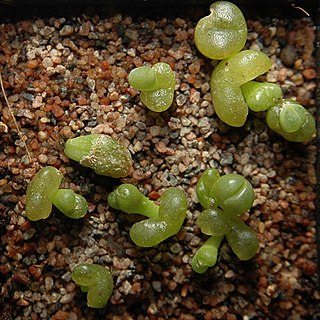
Lithops optica is a species of plant in the family Aizoaceae, endemic to Namibia.

Aloe ferox, commonly known as bitter aloe, is a species of flowering plant in the family Asphodelaceae. This woody aloe is indigenous to southern Africa. It is one of several Aloe species used to make bitter aloes, a purgative medication, and also yields a non-bitter gel that can be used in cosmetics.
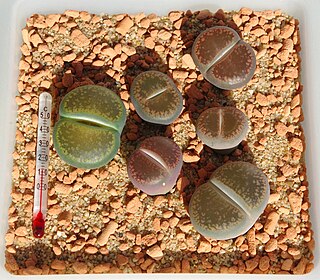
Lithops aucampiae is a species of flowering plant in the family Aizoaceae, found in South Africa. it was named after Juanita Aucamp, who found a specimen on her father's farm in Postmasburg, Northern Cape in 1929.

Portulacaria afra is a small-leaved succulent plant found in South Africa. These succulents commonly have a reddish stem and leaves that are green, but also a variegated cultivar is often seen in cultivation. They are simple to care for and make easy houseplants for a sunny location. In frost-free regions they may be used in outdoor landscaping.

Haworthia truncata, locally known as horse's teeth, is a species of succulent plant in the genus Haworthia. It is found in the Little Karoo region, in the far east of the Western Cape Province, South Africa.

Lithops viridis is a species of plant in the family Aizoaceae.

Lithops salicola is a species of perennial plant in the family Aizoaceae, often called living stones, because of its resemblance to round grey pebbles.
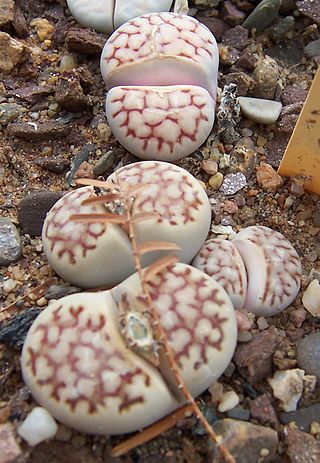
Lithops karasmontana, is a species of flowering plant in the ice plant family Aizoaceae, native to Namibia and South Africa.

Glottiphyllum cruciatum is a rare species of succulent plant, of the family Aizoaceae. It is indigenous to arid areas near Oudtshoorn in the Western Cape, South Africa. The plant has many synonyms including Glottiphyllum angustum.
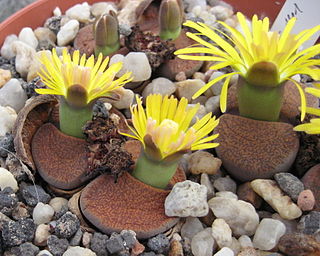
Lithops lesliei is a species of plant in the family Aizoaceae. The plant is collected for its medicinal properties, and has therefore become threatened.

Lapidaria is a monotypic genus of dwarf succulent plants in the family Aizoaceae. The only species it contains is Lapidaria margaretae, also known as the Karoo rose.

Crassula nudicaulis is a succulent plant native to South Africa, and Lesotho.
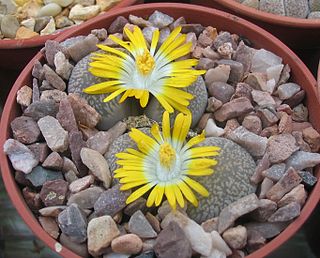
Lithops comptonii is a species of plant in the family Aizoaceae, indigenous to South Africa.

Haworthiopsis viscosa, formerly Haworthia viscosa, is a species of flowering succulent plant from the Western and Eastern Cape Provinces, South Africa.
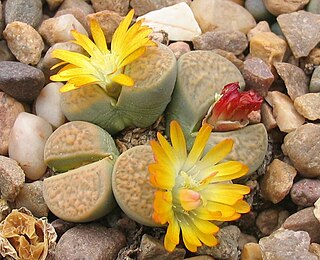
Lithops divergens is a succulent plant species in the genus Lithops of the family Aizoaceae. It is endemic to the western Cape Provinces of South Africa. It is able to withstand intense climatic changes due to its resilience as a succulent. The average annual rainfall for its natural environment is less than 150 mm, occurring primarily in winter which is unusual for a Lithops.
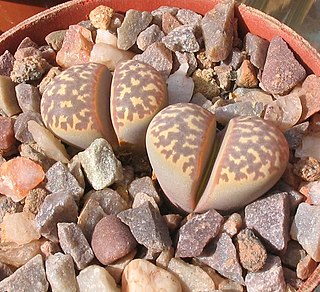
Lithops naureeniae is a species of pebble plant (Lithops), in the family Aizoaceae. It is native to the Northern Cape province of South Africa. The succulent is adapted to the desert climate in which it lives. L. naureeniae was identified in 1980 by Desmond Cole, who became involved in Lithops research in 1947, from a specimen provided to him by Bruce Bayer, curator of the Karoo Botanic Garden, having been collected by Peter V. Bruyns in Namaqualand. It is named after Cole's wife, Naureen Cole. Cole wrote:
I therefore have pleasure in dedicating it to the person who, during the last fifteen years, directly and indirectly, has contributed more to research on and knowledge of the genus Lithops than any other—my wife, Naureen




















